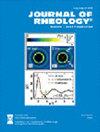利用聚苯乙烯-b-聚丙烯酸正丁酯-b-聚苯乙烯三嵌段共聚物较低的无序温度来提高其高温流动阻力
IF 3.2
2区 工程技术
Q2 MECHANICS
引用次数: 0
摘要
本研究的重点是熔体中聚苯乙烯-b-聚(丙烯酸正丁酯)-b-聚苯乙烯三嵌段共聚物(PS-b-PnBA-b-PS)的温度依赖结构和流变特性,特别是它们具有较低无序温度(LDOT)的能力。为此,合成了不同嵌段长度的共聚物,但以PnBA嵌段为主要组分。小角度x射线散射显示,具有短PS嵌段(~ 10 kg/mol)的共聚物接近LDOT,但没有穿过它。在室温下,由于PS的增强作用,这些共聚物比PnBA均聚物表现出更高的模量,但在高于PS玻璃化转变的温度下流动。增加PS和PnBA的嵌段长度,以保持相同的PS分数,会导致结构和粘弹性行为发生更深刻的变化。这种共聚物穿过LDOT,在高温下导致微相分离和有序状态。与具有短PS嵌段的共聚物相反,即使在远高于PS玻璃化转变的温度下,也没有达到流动状态。相反,在流变学中观察到低频平台,表明微相分离的PS畴的寿命增加。因此,表现出LDOT行为的ABA三嵌段共聚物可以用于设计热塑性弹性体或抗高温流动的压敏粘合剂。本文章由计算机程序翻译,如有差异,请以英文原文为准。
Exploiting the lower disorder-to-order temperature in polystyrene-b-poly(n-butyl acrylate)-b-polystyrene triblock copolymers to increase their flow resistance at high temperature
This work focuses on the temperature-dependent structural and rheological characterization of polystyrene-b-poly(n-butyl acrylate)-b-polystyrene triblock copolymers (PS-b-PnBA-b-PS) in the melt and, in particular, on their ability to show a lower disorder-to-order temperature (LDOT). To this aim, copolymers of varying block lengths, but keeping the PnBA block as a major component, were synthesized. Small-angle x-ray scattering revealed that the copolymers with short PS blocks (∼10 kg/mol) approach an LDOT but do not cross it. At room temperature, these copolymers exhibit higher moduli compared to a PnBA homopolymer due to the reinforcing effect of the PS but are flowing at temperatures above the glass transition of the PS. Increasing the PS and PnBA block length, to keep the same PS fraction, induces more profound changes in the structural and viscoelastic behaviors. Such a copolymer crosses the LDOT, leading to a microphase-separated and ordered state at high temperature. Contrary to the copolymers with short PS blocks, the flow regime was not reached, even at temperatures well above the glass transition of the PS. Instead, a low-frequency plateau was observed in rheology, showing the increased lifetime of the microphase-separated PS domains. ABA triblock copolymers exhibiting an LDOT behavior could, thus, be of interest for the design of thermoplastic elastomers or pressure-sensitive adhesives that can resist the flow at high temperatures.
求助全文
通过发布文献求助,成功后即可免费获取论文全文。
去求助
来源期刊

Journal of Rheology
物理-力学
CiteScore
6.60
自引率
12.10%
发文量
100
审稿时长
1 months
期刊介绍:
The Journal of Rheology, formerly the Transactions of The Society of Rheology, is published six times per year by The Society of Rheology, a member society of the American Institute of Physics, through AIP Publishing. It provides in-depth interdisciplinary coverage of theoretical and experimental issues drawn from industry and academia. The Journal of Rheology is published for professionals and students in chemistry, physics, engineering, material science, and mathematics.
 求助内容:
求助内容: 应助结果提醒方式:
应助结果提醒方式:


